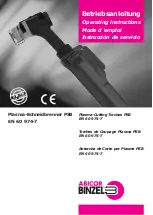
requiring Clear to Send.
Data Set Ready is a D.C. level indicator to the terminal that the local Bit-Driver has power applied.
Signal Ground is the level to which all voltages for the RS-232 interface are referenced.
Data Carrier Detect is a control signal from the Bit-Driver which indicates a signal is being received
from the remote Bit-Driver.
3. SYSTEM MALFUNCTION ISOLATION
- Listed below is a step-by-step test
procedure which can be used to isolate a system malfunction. Steps 1 and 2 are used primarily at
the time of installation and may be skipped if the system has been in operation prior to failure. Once
the cause of failure is determined, further testing is unnecessary. The Bit-Driver test described
below requires the standard RS-232 interface connection. Prior to starting the test, verify that the
DIP switch is set with both NORM and RTS1 switch only in the ON position.
1. Verify that the terminal generates an RTS command on pin 4 by touching the probe to the pad
numbered 4. The - LED should be on. If not, an RTS signal may be generated internal to the Bit-Driver
by turning RTS2 ON and RTS 1 OFF at the DIP switch.
2. Verify that the terminal generates its transmitted data on pin 2 by touching the probe to the pad
numbered 2. The - LED should be ON. If data is being transmitted the + LED will flash. If not, the
terminal is defective or not configured properly. Refer to the nonstandard input/output interface
section on how to identify whether a Null Modem configuration is required.
3. Check the DCD status LED on the front panel. If it is ON, then proceed to step 4. Otherwise
disconnect the two fibers from the rear of the Bit-Driver. In a room with subdued light, place a paper
or foam cup over both the R and T receptacles. The transmitted signal will be reflected off the bottom
of the cup back into the optical receiver to accomplish analog loopback. The DCD status LED should
be ON. If not, check for RTS signal as described in step 1. If RTS is present and RTS1 switch is
ON, then return the Bit-Driver to the factory.
4. Connect the probe tip to the pad labeled 8. The + LED should be ON. If not, return the Bit-Driver
to factory.
5. Connect the probe tip to the pad labeled 5. The + LED should be ON. If not, check the RTS1 and
RTS2 switches. One or the other must be on as determined in Step 1. If + LED is not ON, then return
the Bit-Driver to factory.
6. If not done previously, disconnect the two fibers from the rear of the Bit-Driver. In a room with
subdued light, place a paper or foam cup over both the R and T receptacles. The transmitted signal
will be reflected off the bottom of the cup back into the optical receiver to accomplish analog loopback.
Cause the terminal to generate characters. Both the TD and RD LED’s on the front sheet should
flash. If they do, proceed to step 7. Otherwise connect the probe tip to the pad marked 2. Both the
- LED should be ON and the + LED should flash as data is transmitted. If not, the terminal is not
transmitting data.
7. While generating characters connect the probe tip to pin 3. The - LED should be ON and the +
LED should flash. If not, return the Bit-Driver to the factory.
8. While the terminal is generating characters it should also be displaying the characters. If it is, then
the local Bit-Driver is OK. Proceed with step 9. Otherwise, switch the DP switch so that switches
1 and 3 are ON. The Bit-Driver is now set into a digital loopback mode so that data is not processed
by the Bit-Driver. As the terminal transmits data it should also receive the data. If not, the terminal
or RS232 cable is defective.
Page 2
H. WEISS MACHINERY & SUPPLY
H. WEISS MACHINERY & SUPPLY
PHONE: (718) 605-0395 - www.hweiss.com















































